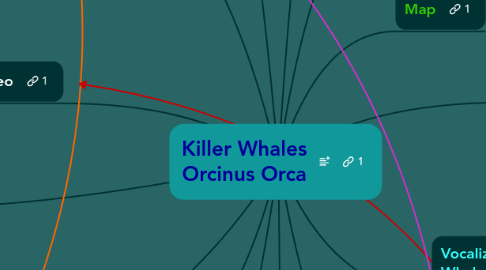
1. Threats
1.1. Polluted Water
1.1.1. People throw Persistent Organic Pollutants (Toxic Chemicals) in Habitat of Killer Whales
1.1.1.1. Also affect the prey of Killer Whales which they need (to eat)
1.1.1.2. Chemicals in water affect Killer Whale's Health
1.2. Less Prey for Killer Whales
1.2.1. Killer Whales than get Less Healthier
1.3. Some people kill Killer Whales on Purpose
1.3.1. Use Killer Whales for Meat and Oil
2. Description
2.1. Size
2.1.1. Six to Eight Metres Long (Male usually Greater)
2.2. Weight
2.2.1. Four to Five Tonne
2.3. Black and White Patterns
2.4. Tall Dorsal Fin (Middle of Back)
2.4.1. Men
2.4.1.1. Around 1.8 metres long in height (triangular)
2.4.2. Female
2.4.2.1. Around 0.9 metres or less in height
2.5. Tail Flukes
2.6. Pectoral Fins
3. Action Plan
3.1. What the Government can Do
3.1.1. Start Programs/Clubs to Protect Killer Whales
3.1.2. Reduce the Pollution of Water
3.2. What I can Do
3.2.1. Convince Other People to help Killer Whales
3.2.2. Donate Money to Killer Whale Foundations
3.3. What Non-Government and Other People can Do
3.3.1. Convince Large Companies to reduce dumping Toxic Chemicals in Ocean
3.3.2. Protest for the Better (Clean Ocean and food) of Killer Whales
3.3.3. Volunteer to help Killer Whales
4. Interesting Facts
4.1. live in pods (family-related groups)
4.1.1. Killer Whales Never Leave Parents, Male or Female
4.2. Use whistles, squeaks to communicate with each other
4.2.1. they can find/hear own pod from severals miles away from distinctive songs
4.2.2. each pods have own unique sound
4.3. Live around for 50-80 years because they have no predators
4.4. Use Clicking Sounds that bounces of fish and other things to find prey
4.4.1. Called Echo-Location
4.5. Only 50 000 Killer Whales Left
5. Photos
6. Life Cycle
6.1. Killer Whales Never Leave their Parents, Male and Female
6.2. From 50- 80 years
6.3. Some Killer Whales die when born and age of 6 months
7. Video
8. Habitat
8.1. Around Canadian Oceans
8.1.1. Atlantic Ocean, around Vancouver Island
8.1.2. Hudson Bay
8.1.3. Gulf of the St. Lawrence
8.2. Water they live in
8.2.1. Temperature of Water
8.2.1.1. From Under 0 Degrees to Warmer Waters
8.2.2. Mostly seen in Several Metres Under Water
8.2.3. Most Killer Whales found in Salt Water
8.3. Air is also needed for Killer Whales
8.3.1. Killer Whales are Mammals so they need Oxygen to live
9. Feeding
9.1. Types of Prey Under Water that Killer Whales Eat
9.1.1. Sea Turtles
9.1.2. Squid
9.1.3. River Otters
9.1.4. Sea Lion
9.1.5. Mainly Fish
9.2. Types of Prey Not in Water that Killer Whales Eat (Only Transient)
9.2.1. Pig
9.2.2. Moose
9.2.3. Deer
10. Map
11. Groups
11.1. Kingdom: Animalia
11.2. Phylum: Chordata
11.3. Class: Mammalia
11.4. Order: Cetacea
11.5. Family: Delphinidae
11.6. Genus: Orcinus
11.7. Species: Orca
12. Resources
12.1. Hinterland Who's Who - Killer Whales
12.2. Species at Risk Public Registry
12.3. Killer Whale Quick Facts
12.4. Youtube- Orcas: Endangered in Puget Sound - Calling for Help
13. Canada Status
13.1. Endangered (threatened)
13.2. Around 50 000 Killer Whales left in World
14. Vocalizations of Killer Whale
14.1. Use Squeaking or Clicking Sound to Communicate with each other
14.2. Echo- Location
14.2.1. A Clicking Sound that bounces of prey. Used For finding Prey to Eat
